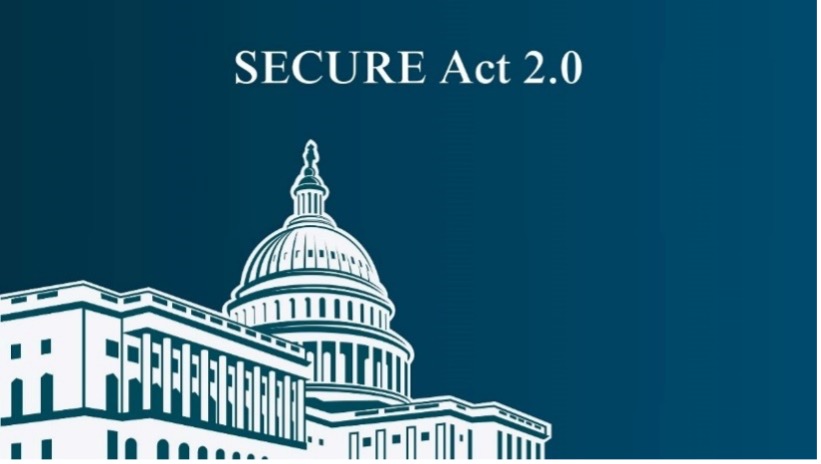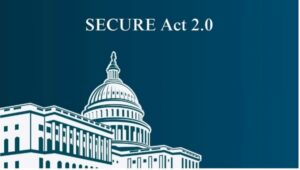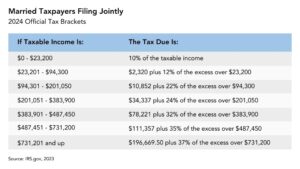
Rules and Regulation Changes that Could Impact Your Finances in 2024
In the ever-evolving financial landscape, staying informed about the latest changes and potential implications for your retirement savings is crucial. Shifts in retirement regulations define 2024, and we’re committed to keeping our clients abreast of these developments.
The SECURE Act 2.0, enacted in late 2022, has dozens of provisions to encourage more people to save through the workplace and other plans, to help boost retirement savings, and to urge small employers to offer retirement plans. Some of the provisions went into effect in 2023. Others start in 2024, 2025, 2026, and 2027. While its impact will extend to all savers, some targeted provisions, particularly those affecting higher-net-worth investors, will take effect in 2024.
It’s important to remember that rules and regulations can change without notice, and there is no guarantee that the treatment of certain legislation will remain the same in 2024 and beyond.1
SECURE 2.0

Below are some of the most significant SECURE 2.0 provisions that go into effect this year:2,3
1. Changes to RMDs in Roth Accounts: Roth accounts in employer retirement plans are exempt from the required minimum distribution (RMD) requirements.
2. IRA catch-up contributions: IRA catch-up contributions, previously limited to $1,000 for people aged 50 and over, will be indexed to inflation, meaning they could increase yearly based on federally determined cost-of-living increases.
3. Student loan benefit: Employers can now “match” employee student loan payments with matching payments to a retirement account such as a 401(k) plan, giving workers a potential added employee benefit and an extra incentive to save for retirement while paying off educational loans.
4. Tax and penalty-free rollovers from 529 accounts to Roth IRAs are now allowed under certain conditions. Beneficiaries of 529 accounts who did not use all the assets for education are permitted to roll over up to $35,000 (lifetime limit). Rollovers from 529 accounts are subject to Roth IRA annual contribution limits, and the 529 account must have been open for more than 15 years.
5. SIMPLE account changes: Employers are allowed to make additional contributions to employee SIMPLE accounts, up to the lesser of 10% of compensation or $5,000, indexed for inflation after 2024.
6. Distributions from retirement plans for personal emergencies are allowed penalty-free for one distribution per year of up to $1,000, with the choice to repay the distribution within three years.
Required Minimum Distributions (RMDs)
There were several changes to RMDs in both SECURE and SECURE 2.0. These new provisions impact retirees, their spouses, and others who may eventually inherit their assets.4
SECURE 2.0 raised the RMD age for retirees to 73 last year, and the age requirement is scheduled to increase to 75 over the next decade.
Remember that significant changes were also made to the retirement status quo by requiring that most beneficiaries draw down their inherited IRA within 10 years after the IRA creator’s death. Beneficiaries can no longer “stretch out” the payments over their life expectancies. Exceptions to this rule have been carved out for spouses and minor children beneficiaries. Adult children, grandchildren, and most other designated beneficiaries are subject to the 10-year rule, meaning they may pay taxes sooner than anticipated.
If you are the owner of the retirement assets, you should take this new provision into account when devising your estate strategy. If you have recently inherited this type of asset, you need to know the new rules and prepare accordingly.
Social Security

Even with sizable retirement assets, you should still factor Social Security into your retirement savings, income distribution, and tax strategies. Here are Social Security changes to be aware of for 2024:5
• The annual cost-of-living adjustment (COLA) increase for Social Security benefits for more than 71 million Americans is 3.2 percent, beginning in January 2024.
• The maximum earnings subject to the Social Security tax has increased to $168,600.
• The earnings limit for workers younger than “full” retirement age increased to $22,320. Social Security deducts $1 from benefits for each $2 earned over the limit.
• The earnings limit for people reaching their “full” retirement age increased to $59,520 in 2024. Social Security deducts $1 from benefits for each $3 earned over the limit until the month the worker turns “full” retirement age.
• There is no limit on earnings for workers who are “full” retirement age or older for the entire year.
Tax Brackets and Rates
The IRS has announced the annual inflation adjustments for the tax year 2024 beginning January 1, 2024. They are not the numbers you’ll use to prepare your 2023 tax returns in 2024. You’ll use these numbers to prepare your 2024 tax returns in 2025. Currently, there are seven tax rates in 2024: 10%, 12%, 22%, 24%, 32%, 35%, and 37%. Here’s how those break out for married taxpayers filing jointly:6

College Aid
Changes have been implemented to the Free Application for Federal Student Aid (FAFSA) form, with the Department of Education calling it the “most ambitious and significant redesign of the federal student aid application in decades.”7
In addition to making it easier to complete, several other FAFSA changes for the 2024 school year may or may not benefit your students. The new approach will be most favorable for lower-income students and less so for families with multiple children in college, small business owners, and households with divorced parents. Here are some highlights of the new FAFSA:
• Multiple students in college—The FAFSA overhaul will remove the benefit for families with more than one child.
• Small-business owners and family farms—The new FAFSA removes a benefit that allowed owners of small businesses and family farms to exclude their business and farm assets from the FAFSA as long as they did not employ more than 100 full-time employees.
• Divorced parents—With the new formula, the parent who has spent the most money on the child will complete the FAFSA, which will usually be the parent who is better off financially. On the other hand, child support will be reported as an asset rather than as income, reducing the impact on a student’s financial aid eligibility.
• Grandparent contributions—Starting with the 2024-2025 school year, qualified distributions made by grandparents and others from qualified college savings plans will no longer be taxed as a child’s untaxed income, which may reduce a student’s expected family contribution.
Professional guidance can help
There are nuances and complexities to these rule and regulation changes. How each could impact your retirement preparedness, tax considerations, estate strategies, or college savings depends on your individual situation and circumstances.
As financial professionals, we can help you navigate these changes. Please contact us to set up a time to delve deeper into these issues as you pursue your financial goals. As always, we’re here to help.
1. This article is for informational purposes only and is not a replacement for real-life advice. Consult your tax, legal, and accounting professionals before modifying your tax strategy.
2. Fidelity.com, November 2023
https://www.fidelity.com/learning-center/personal-finance/secure-act-2#:~:text=Starting%20in%202024%2C%20RMDs%20will%20no%20longer%20be,emergency%20savings%20account%20associated%20with%20a%20Roth%20account
3. ASPPA, January 2023
https://www.asppa.org/news/key-secure-20-act-provisions-and-effective-dates
4. Foley & Larden LLP, February 2023
https://www.foley.com/insights/publications/2023/02/secure-2-minimum-required-distribution-rules/
5. Social Security Administration, October 2023
https://www.ssa.gov/news/press/releases/2023/#10-2023-2
6. Forbes, November 2023
https://www.forbes.com/sites/kellyphillipserb/2023/11/09/irs-announces-2024-tax-brackets-standard-deductions-and-other-inflation-adjustments/?sh=113d5961c139
7. WealthManagement.com, May 2023
https://www.wealthmanagement.com/college-planning/fafsa-gets-overhaul
To qualify for the tax-free and penalty-free withdrawal of earnings, Roth IRA distributions must meet a 5-year holding requirement and occur after age 59½. Tax-free and penalty-free withdrawals can also be taken under certain other circumstances, such as the owner’s death. The original Roth IRA owner is not required to take minimum annual withdrawals.
Once you reach age 73, you must begin taking RMDs from a traditional IRA in most circumstances. Withdrawals from traditional IRAs are taxed as ordinary income and, if taken before age 59½, may be subject to a 10% federal income tax penalty.
Once you reach age 73, you must begin taking required minimum distributions (RMDs) from your 401(k) or any other defined contribution plan in most circumstances. Withdrawals from your 401(k) or any other defined contribution plans are taxed as ordinary income and, if taken before age 59½, may be subject to a 10% federal income tax penalty.
A 529 plan is a college savings plan that allows individuals to save for college on a tax-advantaged basis. The state tax treatment of 529 plans is only one factor to consider before committing to a savings plan. Also, consider any fees and expenses associated with a particular plan. Whether or not a state tax deduction is available will depend on your state of residence. State tax laws and treatment may vary. State tax laws may be different from federal tax laws. Earnings on nonqualified distributions will be subject to income tax and a 10% federal penalty tax.
Like a traditional IRA, withdrawals from a SIMPLE IRAs are taxed as ordinary income and, if taken before age 59½, may be subject to a 10% federal income tax penalty. In most circumstances, once you reach age 73, you must begin taking required minimum distributions.
 Secure Document Sharing
Secure Document Sharing


